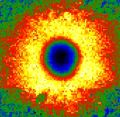Speaker
Description
Structural color filters use nano-sized elements to allow for selective transmission of the incident light. Compared to the traditional, pigment- and dye-based color filters, they offer a cheaper, less environmentally harming and more scalable alternative of color filtering. However, their structural nature makes them very sensitive to the illumination direction and leads to spectral shifts in their optical response as the incident angle varies. So far, strategies for the mitigation of this issue relied heavily on the design of the color filter’s geometry, which inevitably limited their overall efficiency, often by restricting some light polarization states. Here, we demonstrate a highly flexible compensation method for the angle-dependent spectral shifts by introducing a conformal VO2 layer onto the bare aluminum structural color filters.
Driving the VO2 through its insulator-metal transition has enabled us to restore the original spectral position of the color filter’s transmission maximum even when the color filter was tilted from the light source by 15°, while 80% of the transmission was maintained and narrower FWHM was achieved. The key advantage of the presented compensation method lies in its flexibility: As an additional fabrication step, it can be seamlessly integrated into the manufacturing of any structural color filter, regardless of its design. Our findings establish dynamically tunable phase-change materials, such as VO2, as a possible solution for angle-dependent spectral shifts.

